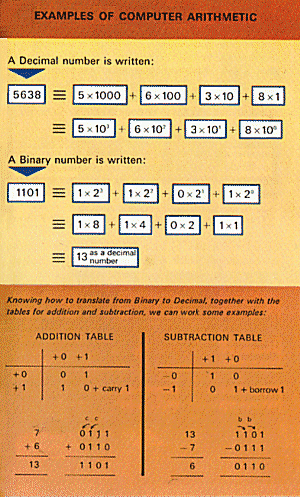
 |
Binary Arithmetic |
Binary Arithmetic |
|
 |
We have seen that information travels along the highways as pulses or
no-pulses. If we call each of these a digit, then the arithmetic unit has
to do its arithmetic with only two digits instead of the ten that we use
for our own calculations. The system using ten digits is the decimal system,
the system using only two digits is called the binary system. The numbers
used in the binary system are 0 and 1, so that a pulse can represent a 1
and a no-pulse a 0 (equally well the reverse would be true but will not be
used).
The examples at the top of the page opposite show how the two number systems are made up. Those students who already have some knowledge of arithmetic will know that addition and subtraction follow fixed rules and that two tables can be built up, one for addition and one for subtraction, which will give the answer for any two digits which we wish to add or subtract. For binary arithmetic there are four entries in each table, as shown opposite. Keeping an eye on these tables will help when following the examples given of binary addition and subtraction.
|
Reproduced from "How it Works" Ladybird Series